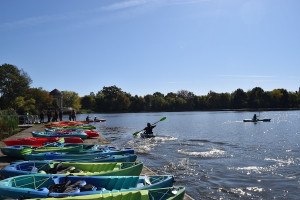Clarke’s LOVE Park Plan: Too Much, and Not Enough, of a Good Thing

Photo: By Smallbones on Wikimedia
City Council President Darrell Clarke is floating a plan to take care of rehabilitating LOVE Park the same way the city is going about rehabilitating the parking garage under it: By having private business foot the bill for the repairs.
Mayor Nutter has already announced that the garage would be sold to Chicago-based InterPark, which bid $30 million for it. InterPark would then renovate the garage on its own dime and restore the park – formally, John F. Kennedy Plaza still – with $16.5 million from the city.
Clarke has come up with a proposal to get others to pay for that $16.5 million park rehab: Lease most of the park space not taken up by the fountain in the middle to restaurant operators who would operate a mix of outdoor and enclosed eateries.
Is it possible to go too far with a good idea?
Clarke may have done so with the proposed design he released at a news conference Dec. 5. While he maintains that the proposal would “enhance the experience of the park” while “maintaining the park-like setting,” the design as presented would pretty much privatize most of the space park visitors can now use for sitting or gathering.
In principle, Clarke has the right idea with his proposal: Let’s save scarce public funds for more pressing needs by getting the private sector to pick up the tab for redoing LOVE Park just as the mayor has done for its garage. But where the garage is just – and only – a place to store cars, the park has multiple uses, and the proposed design unveiled on Dec. 5 crowds out most of the others, especially where the restaurants are fully enclosed.
This, however, is not an insurmountable obstacle to achieving the goal Clarke seeks while preserving access to all of the park’s open space. The answer involves the hottest trend in dining today: mobile cuisine.
Food trucks and other mobile food vendors can prepare delicious dishes in minimal space, and events featuring them now draw huge crowds not only here but in other cities. They can, and have, been incorporated into permanent food court-like settings such as the one Temple University has along 12th Street where it runs through the campus.
To adapt this concept to a “park-like setting,” we could take a cue from the Pennsylvania Horticultural Society’s most recent Pop-Up Garden, which transformed a vacant lot across Broad Street from the University of the Arts into a fun and welcoming space that combined garden, lounge, restaurant and beer garden, using shipping containers to handle the food and beverage service. Public access to the entire site was preserved and the food vendor was able to turn a decent profit all the same.
There are other advantages to a mobile-vendor approach. More vendors could be accommodated, increasing choice for visitors. Leases could rotate more frequently, providing constantly changing variety that would keep visitors coming back. And the total take for the city from such leases could be greater thanks to the larger number of vendors the space could accommodate.
We should take Clarke’s proposed design as the start of a path to a new and livelier LOVE Park, not as its final form. There’s much to recommend it, but as with many other good ideas, it could stand some refinement.


